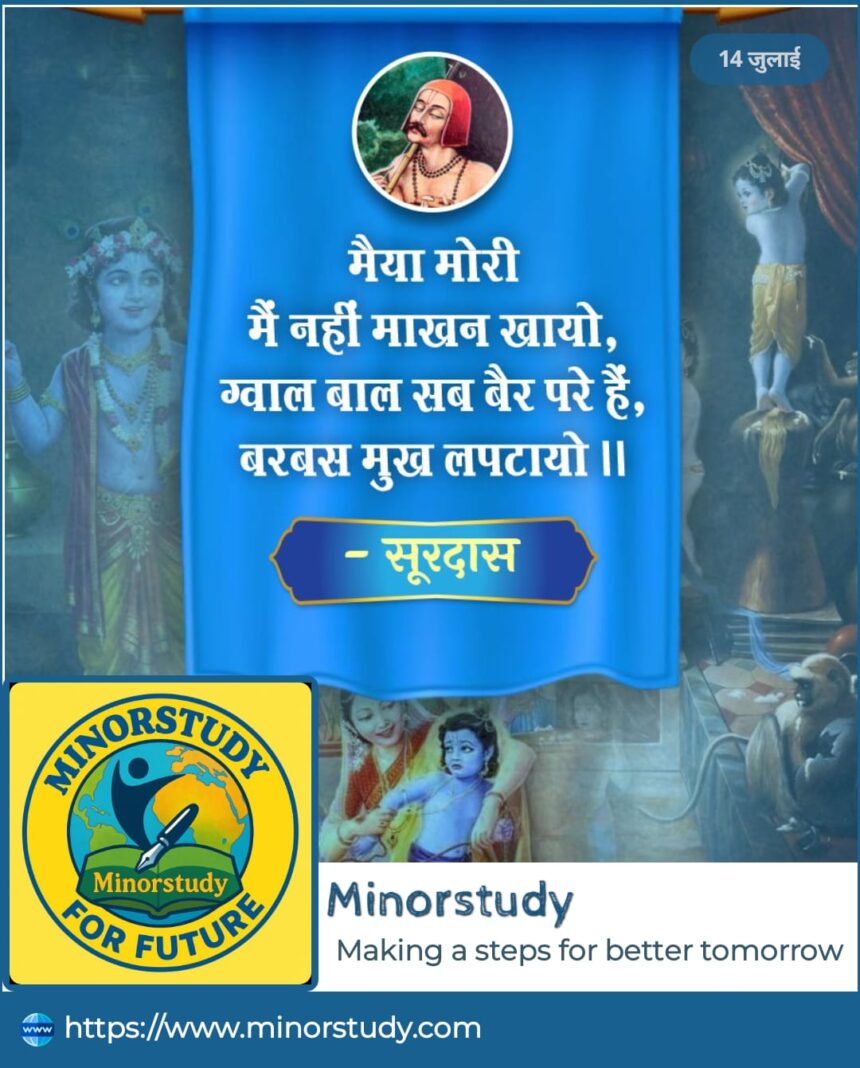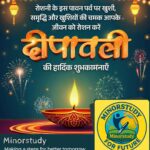7 Heart-Melting Truths from Surdas’s ‘Maiya Mori Main Nahin Makhan Khayo’ – A Timeless Ode to Innocence and Divine Love
“Maiya Mori Main Nahin Makhan Khayo, Gwal Bal Sab Bair Pare Hain, Barbas Mukh Lapatayo”
(“O Mother, I have not eaten the butter. The cowherd boys falsely accuse me, and you forcibly smear my mouth!”)
- 📖 Historical Background: Surdas and His Eternal Verse
- 📜 Origin and Meaning of the Composition
- 🕰️ Timeline: Surdas and the Bhakti Movement
- 🌸 7 Heart-Melting Truths Hidden in This Leela
- 1. Innocence is Divine Power
- 2. Leela is the Lord’s Language
- 3. Motherly Love Transcends Logic
- 4. Accusation is Part of Divine Play
- 5. Child-God Teaches Us to Smile Through Conflict
- 6. The Power of Bhakti Literature
- 7. The Divine Lives in Everyday Moments
- 🔍 Significance in Modern Life
- 📅 Observance and Cultural Importance
- 💐 Wishing Inspired by Surdas Ji’s Poem
- ❓ Frequently Asked Questions (FAQs)
- Q1. Who was Surdas?
- Q2. What does “Maiya Mori Main Nahin Makhan Khayo” mean?
- Q3. What is the relevance of this poem today?
- Q4. What is Sur Sagar?
- Q5. Why is Krishna portrayed as mischievous?
- 🌼 Importance in Life and Society
- 🪔 Conclusion: Surdas’s Butter-Smeared Krishna Lives in Our Hearts
This immortal line from Surdas, the blind poet-saint of the Bhakti era, is not just a poetic complaint of a divine child—it is a soul-stirring expression of innocence, leela (divine play), and the unbreakable bond between mother and child, between God and devotee, and between truth and illusion.
📖 Historical Background: Surdas and His Eternal Verse
🧑🦯 Who Was Surdas?
Born: Circa 1478 CE in Sihi, Haryana (some sources say Braj region, UP)
Died: Circa 1583 CE
Spiritual Master: Vallabhacharya (founder of the Pushtimarg sect)
Language: Braj Bhasha
Famous Work: Sur Sagar – An anthology of devotional songs dedicated to Lord Krishna
Though blind by birth, Surdas “saw” Krishna more vividly than most people can with sight. His devotion, imagination, and lyrical mastery made him one of the greatest poets of Indian devotional literature.
📜 Origin and Meaning of the Composition
“Maiya Mori Main Nahin Makhan Khayo” is one of the most cherished Krishna Leela Pad (playful devotional poems) from Sur Sagar. It captures a tender moment when young Krishna is accused by other gopas (cowherd boys) of stealing butter. He innocently pleads with his mother, Yashoda, denying the act despite evidence smeared across his face.
The Deeper Meaning:
The poem reflects Krishna’s divine mischief.
It also signifies how the Supreme Being remains untouched by worldly accusations, yet plays along lovingly in the drama of human emotions.
🕰️ Timeline: Surdas and the Bhakti Movement
| Period | Event |
|---|---|
| 1478 CE | Surdas’s birth in Braj region |
| Early 1500s | Becomes disciple of Vallabhacharya, enters devotional path |
| 1510–1580s | Composes most of Sur Sagar and spreads Krishna Bhakti |
| 1583 CE | Surdas attains Samadhi |
| Today | Poems sung across India, especially in Braj, Gujarat & temples |
🌸 7 Heart-Melting Truths Hidden in This Leela
1. Innocence is Divine Power
Even though Krishna is God, in this leela, he behaves like a lovable, naughty child. His innocent denial shows that innocence can be more powerful than reason.
2. Leela is the Lord’s Language
Krishna’s leelas are not just playful stories—they convey deep philosophical truths. Here, Krishna, the master of creation, pretends to be caught, illustrating how God allows himself to be bound by love.
3. Motherly Love Transcends Logic
Yashoda, despite seeing butter on Krishna’s lips, listens to him. This shows that love doesn’t always follow evidence—sometimes, it listens to the voice of the heart.
4. Accusation is Part of Divine Play
Gwal-bal accuse Krishna, but it’s part of the cosmic drama. In life too, misunderstandings may come, but one must learn to play along gracefully and lovingly.
5. Child-God Teaches Us to Smile Through Conflict
Krishna’s smile, even when falsely accused, teaches us to handle criticism and confrontation with charm and wit, not bitterness.
6. The Power of Bhakti Literature
This single poem evokes humor, emotion, devotion, and philosophy—proof that Bhakti poetry touches the soul deeper than dry theology.
7. The Divine Lives in Everyday Moments
The poem makes even a simple moment—eating butter—feel holy. This is the core of Bhakti: seeing the divine in daily life, in the mundane and the playful.
🔍 Significance in Modern Life
💫 Personal Level
Encourages one to stay childlike, pure, and honest.
Shows that devotion doesn’t need grandeur—just love and faith.
🧑🤝🧑 Social Level
Reminds us to approach others with trust and softness, not suspicion.
Urges parents to see divinity in their children.
🧘♂️ Spiritual Level
Portrays a non-threatening, playful image of God, making spirituality accessible and joyful.
Connects heart and devotion, away from fear-based worship.
📅 Observance and Cultural Importance
Recited and sung especially during Janmashtami, Radha Ashtami, Holi, and Hari Katha.
Common in Bhajans and Kirtans in temples and satsangs across North India and Gujarat.
Adapted into classical Indian music, dance dramas, and school performances.
Frequently taught in school Hindi literature curriculums to inculcate cultural values.
💐 Wishing Inspired by Surdas Ji’s Poem
🌼 May your life be as sweet as Krishna’s butter,
Your heart as pure as a child’s prayer,
And may your eyes see the Lord in every loving smile.
On this day, let Surdas’s devotion melt the hardness within us. Jai Shri Krishna! 🌼
❓ Frequently Asked Questions (FAQs)
Q1. Who was Surdas?
A: Surdas was a blind devotional poet of the Bhakti movement, known for his heartfelt songs about Krishna, especially his childhood leelas.
Q2. What does “Maiya Mori Main Nahin Makhan Khayo” mean?
A: It means “O Mother, I have not eaten the butter.” Krishna pleads innocence despite being caught.
Q3. What is the relevance of this poem today?
A: It reminds us of the beauty of innocence, devotion, and mother-child relationships. It offers relief from our fast-paced, judgment-heavy modern lives.
Q4. What is Sur Sagar?
A: Sur Sagar (Ocean of Melody) is the primary poetic collection of Surdas, comprising hundreds of Krishna-centric devotional songs.
Q5. Why is Krishna portrayed as mischievous?
A: To make divinity relatable and to show that love transcends rules. His leelas are divine metaphors.
🌼 Importance in Life and Society
In Daily Life:
Brings joyful spirituality into the home.
Inspires storytelling and bonding in families, especially with children.
In Culture:
Preserves India’s oral and musical tradition.
Enriches classical arts: music, dance, theatre.
In Devotion:
Builds emotional intimacy with the divine.
Shifts focus from fear-based worship to love-based Bhakti.
🪔 Conclusion: Surdas’s Butter-Smeared Krishna Lives in Our Hearts
“Maiya Mori Main Nahin Makhan Khayo” is more than just a poem. It is a window into a world where God laughs, lies adorably, and steals hearts—not just butter. Surdas gives us not just Krishna’s portrait, but our own reflection—a mix of innocence, love, mischief, and longing.
Let us cherish that child within us. Let us never be too grown-up to see God through the eyes of a child. And when accused by life’s challenges, may we too smile sweetly and say—
“Maiya Mori, Main Nahin…”









Hello there, just became alert to your blog through Google, and found that it’s truly informative.
I am going to watch out for brussels. I will be grateful if
you continue this in future. Lots of people will be
benefited from your writing. Cheers!